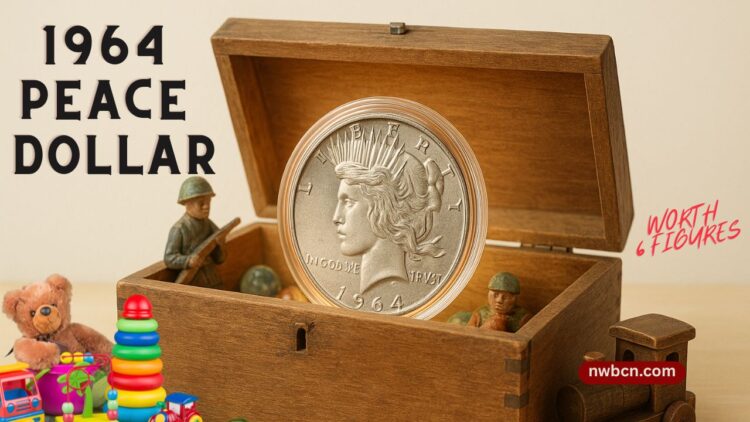There’s a captivating tale that surfaced on niche coin‑collecting forums and whisper‑circles: a child discovered a shiny Peace Dollar replica in a toy chest—initially dismissed as a play coin—only to realize it was a genuine 1964 Peace Dollar, valued at over six figures.
While it makes for a sensational headline, the official numismatic community remains unconvinced: no verified 1964 Peace Dollar has ever surfaced, let alone one discovered in a toy box and worth such a sum.
Yet the story persists, fueled by the mystique surrounding 1964 Peace Dollars—coins that were planned, struck in trial, then destroyed, and have remained unconfirmed in existence.
Let’s peel back the layers: the real historical context, the persistent rumors, and what’s known—and unknown—to date.
1921–1935: The Original Era of the Peace Dollar
- Launch & Design: Created as a symbol of post‑World War I peace. Sculpted by Anthony de Francisci and first issued in late 1921.
- Mintage Span: Produced in Philadelphia (1921–1928) and again in 1934–1935.
- Design Notes: A softer, more modern design compared to earlier Morgan Dollars, symbolizing Liberty and peace.
1964–1965: The Rumored Comeback
| Aspect | Detail |
|---|---|
| Reason for Minting | Rising silver value and shortages prompted Congress and President Kennedy/Johnson to authorize 45 million Peace Dollars in 1964–65. |
| Proof & Trial Runs | Denver Mint reportedly struck ~316,076 trial pieces in May 1965 (dates on dies read “1964‑D”). |
| Destruction | On May 24, 1965, President Johnson ordered destruction; coins melted by weight, not counted, allowing the possibility of escape. |
| Official Mint Records | All test/trials allegedly destroyed. Two test coins reportedly survived briefly (vaulted until 1970) before final destruction. |
| Legal Status | If one exists, it remains U.S. government property and subject to seizure—no statute of limitations. |
| Reported Survivors | No authenticated examples surfaced; PCGS offered $10,000 to view one, with no response. |
| Counterfeit/Fantasy Pieces | “Fantasy” 1964‑D Peace Dollars have been crafted by private presses. |
Why the “Toy Box Find” Remains Mythical
- No Documented Case: No museum, auction house, grading service (NGC/PCGS), or US Mint record verifies a toy‑box discovery.
- Coin Weight Accounting: All struck coins were measured by weight—leaving theoretical gaps, but no tangible evidence.
- Legal and Practical Barriers: Any discovered example would likely be seized immediately and cease to circulate.
- Internet Hype: Forums often amplify unverifiable stories—like the toy‑box narrative—without substantiating physical proof.
Why People Love This Story
- Fairy‑Tale Appeal: A child accidentally discovering hidden fortune in a toy chest—modern treasure hunt!
- Rarity Mythos: The 1964 Peace Dollar is considered the “holy grail” of U.S. coins; the lack of confirmed survivors amplifies fascination.
- Numismatic Hope: Collectors dream of unearthing mint‑uns, government‑lost coins; this legend fuels speculation.
Expert Consensus & Fact Check
- Coin experts call the 1964‑D Peace Dollar “the coin whose existence has never been confirmed.”
- Grading services state: “not one genuine example has surfaced.”
- Mint Documentation: Confirms striking and melting events, but no surface survivors or credible chain‑of‑custody.
- Legal Risks: Ownership—if genuine—could lead to government seizure, as official property.
Could a Six‑Figure Value Be Real?
- Hypothetical Worth: Should a certified genuine 1964 Peace Dollar emerge, demand would skyrocket. PCGS/NGC could grade it as a Myers Mint State specimen.
- Estimated Market Value: While impossible to price exactly, comparisons to other rare U.S. pattern coins suggest well into six figures—potentially $100,000+.
- Uncertainty Factors: Authentication challenges, government claims, and legal ownership issues could depress marketability.
Separating Fact from Fiction
- Confirmed Facts:
- Peace Dollars were struck in 1921–1935.
- ~316,076 trial pieces dated “1964-D” were struck and melted in 1965.
- Mint performed destruction by weight, leaving theoretical loss.
- No authenticated modern example exists.
- Ownership claims would be legally questionable.
- Speculative/Myth:
- A child found one in a toy box.
- It was initially treated as a replica, then revealed as genuine.
- It sold or verified at six‑figure value.
The tale of a child unknowingly discovering a genuine 1964 Peace Dollar in a toy box and the coin being worth six figures remains pure folklore, not verified history. The coin’s backstory—struck, melted, and rumored lost—provides fertile ground for legend. However, numismatic experts and official records assert no authenticated example has ever surfaced.
Yet the myth endures because it taps into the universal fantasy of hidden treasure and the allure of rare coins. Should a genuine specimen ever appear, it would undoubtedly transform the coin world—but it would also bring legal complexity due to U.S. government claims on uncirculated prototypes.
Until such a discovery is authenticated, graded, and handled through legal means, the story remains a fascinating “what if”, perfect for sparking collectible dreams—but not suitable for citation as fact.
Frequently Asked Questions
1. Could a child actually find a real 1964 Peace Dollar in a toy box?
Not according to any known evidence. No authenticated 1964 Peace Dollars have surfaced. The legend likely stems from hopeful speculation, not documented cases.
2. If one was real, could it be worth six figures?
Yes—if authenticated by major grading services and legally owned, a genuine 1964 Peace Dollar could sell for hundreds of thousands, given its extreme rarity and numismatic importance.
3. Why haven’t any been confirmed yet?
Because all known specimens were reportedly melted. No verified example exists in private collections or institutions. U.S. Mint and grading authorities state no genuine examples have been found.
